
 |
|
|||||||
| Forum Rules | Firearms Safety | Firearms Photos | Links | Library | Lost Password | Email Changes |
| Register | FAQ | Calendar | Today's Posts | Search |
 |
|
|
Thread Tools | Search this Thread |
|
|
#1 |
|
Senior Member
Join Date: October 22, 2016
Posts: 3,888
|
S&W Model 1... safe to shoot?
I was watching Ian of Forgotten Weapons Q&A video earlier today and one of the questions he got was what .22 Short ammunition could be used today to shoot the S&W Model 1 revolver that was made for black powder .22 Short, which to Ian's knowledge (and my own) is no longer made.
Ian's response was to use .22 CB or .22 BB ammo because it's fired by the primer only, but he's still not sure as he is concerned about the quality of the steel in 150 year old guns. He said that it would be best to seek out people with more expertise in the S&W Model 1. It got me to thinking if it would be safe to shoot the S&W Model 1's and I came to the conclusion that, so long as the revolver's timing is good and it locks up and aligns the chamber with the bore, then it should be just fine because I doubt that rimfire priming compounds in the 1860's is much different in pressure than it is today. What do you gentleman think? Are these old, old guns safe to shoot with using the primer only as a propellant? EDIT: Correction. I originally said CCI .22 CB Short, but I don't believe that ammunition is primer only.
__________________
"We always think there's gonna be more time... then it runs out."
Last edited by TruthTellers; January 17, 2018 at 06:17 PM. |
|
|
|
|
#2 |
|
Senior Member
Join Date: April 12, 2010
Location: Lake Martin, AL
Posts: 3,311
|
I can't help with the specific question, but I would agree with you and your friend.
I have and shoot from time to time two S&W Safety Hammerless models (known by some as lemon squeezers) in .38 S&W. One is the New Departure 3rd model manufactured from 1896 to 1897. The other one is a New Departure 4th model shipped from the factory on May 2, 1901. |
|
|
|
|
#3 |
|
Senior Member
Join Date: October 22, 2016
Posts: 3,888
|
I'd have no concerns about .32 and .38 S&W black powder revolvers in good working order because I can make my own black powder ammo since they're centerfire cartridges, it's the rimfires that I'm uncertain about.
__________________
"We always think there's gonna be more time... then it runs out."
|
|
|
|
|
#4 |
|
Junior member
Join Date: October 20, 2012
Posts: 5,854
|
They need to make a reproduction of this gun, chambered for modern smokeless .22 Short.
|
|
|
|
|
#5 |
|
Member
Join Date: January 15, 2018
Posts: 67
|
I had an old friend who has now passed away that regularly shot an old Model 1 in 22 short why he enjoyed that little gun so much I do not know, He used 22 cb shorts. I remember well the smile on his face when he got that gun out of the safe. So from experience has long as the gun is proper working order no issues
|
|
|
|
|
#6 |
|
Senior Member
Join Date: June 30, 2017
Location: Columbia Basin Washington
Posts: 415
|
Ok, years ago I owned 2 S&W tip ups.
After discussion with a local gunsmith, we did a test fire using BB caps. Both guns were well times and as solid as 120 year old could be. It worked, but I only trusted 2 cylinders in each gun. Very cool experience, but I don't think I would ever do it again. Eventually sold both to buy a 2nd gen Colt SAA. |
|
|
|
|
#7 |
|
Senior Member
Join Date: October 16, 2014
Location: Iowa
Posts: 1,634
|
I have yet to acquire one of those but I'll shoot mine. I'm pretty sure the gun is not going to blow up or anything like that. Assuming the gun is in good working order it should be fine. Mine biggest concern is that the gun could break at any time and fixing it is going to be cost prohibitive. This is the biggest risk and something you'll have to consider before shooting. I'll use .22 CB shorts.
|
|
|
|
|
#8 |
|
Staff
Join Date: April 13, 2000
Location: Northern Virginia
Posts: 41,390
|
Primer-only ammo should be OK in an older revolver like a No. 1. Peak pressure is quite low.
__________________
"The gift which I am sending you is called a dog, and is in fact the most precious and valuable possession of mankind" -Theodorus Gaza Baby Jesus cries when the fat redneck doesn't have military-grade firepower. |
|
|
|
|
#9 |
|
Senior Member
Join Date: November 3, 2009
Location: Not close enough to the beach
Posts: 1,477
|
Shooting primer-only ammo in your model 1 may be safe, but why take a chance on hurting yourself or a 150 y/o revolver?
|
|
|
|
|
#10 |
|
Senior Member
Join Date: January 3, 2014
Location: Land of the Pilgrims
Posts: 2,033
|
Howdy
Here are a few Smith and Wesson 22 caliber Tip Ups. They are all 7 shot revolvers and they were all chambered for 22 Shorts. Why? Because that is the only 22 rimfire cartridge that existed at the time. Obviously the name 22 Short came along after the 22 Long was developed. And at the time these little revolvers were made, the only ammunition available was loaded with Black Powder. At the time S&W controlled the Rollin White patent for boring a revolver chamber all the way through to accept metallic cartridges. No other company could build a cartridge revolver with the chambers bored all the way through, or S&W would sue them. No.1 1st Issue, Fifth Type. Shipped in 1859. Notice the frame is brass, the silver plating has almost worn completely off. Notice the tiny round side plate, one of the ways this model is identified. 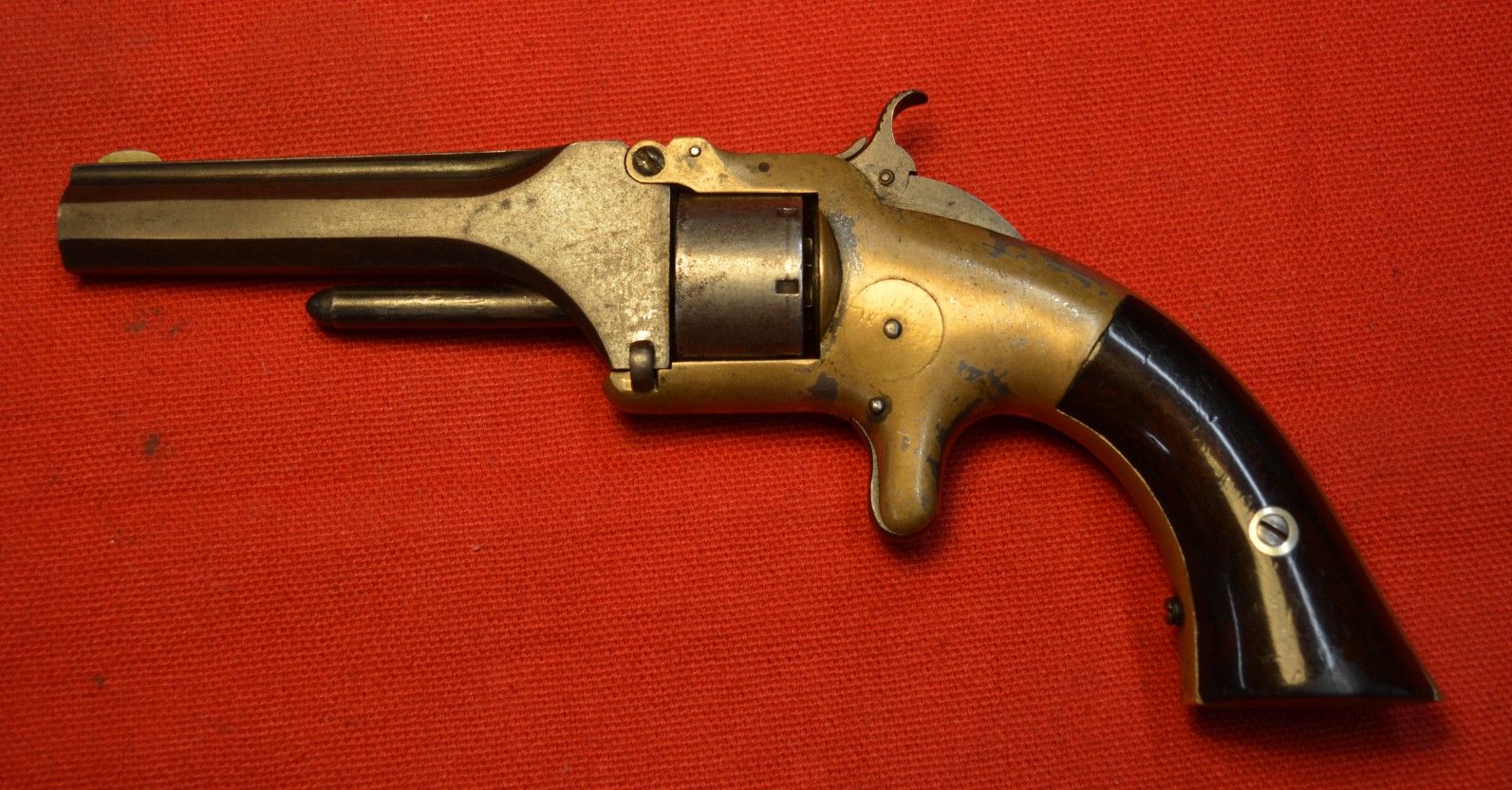 No.1 2nd Issue. Made sometime between 1860 and 1868. The frame is still brass, this one is nickel plated but you can see the brass showing through on the edges of the frame. This model had a larger side plate to make it easier to access the internal parts. 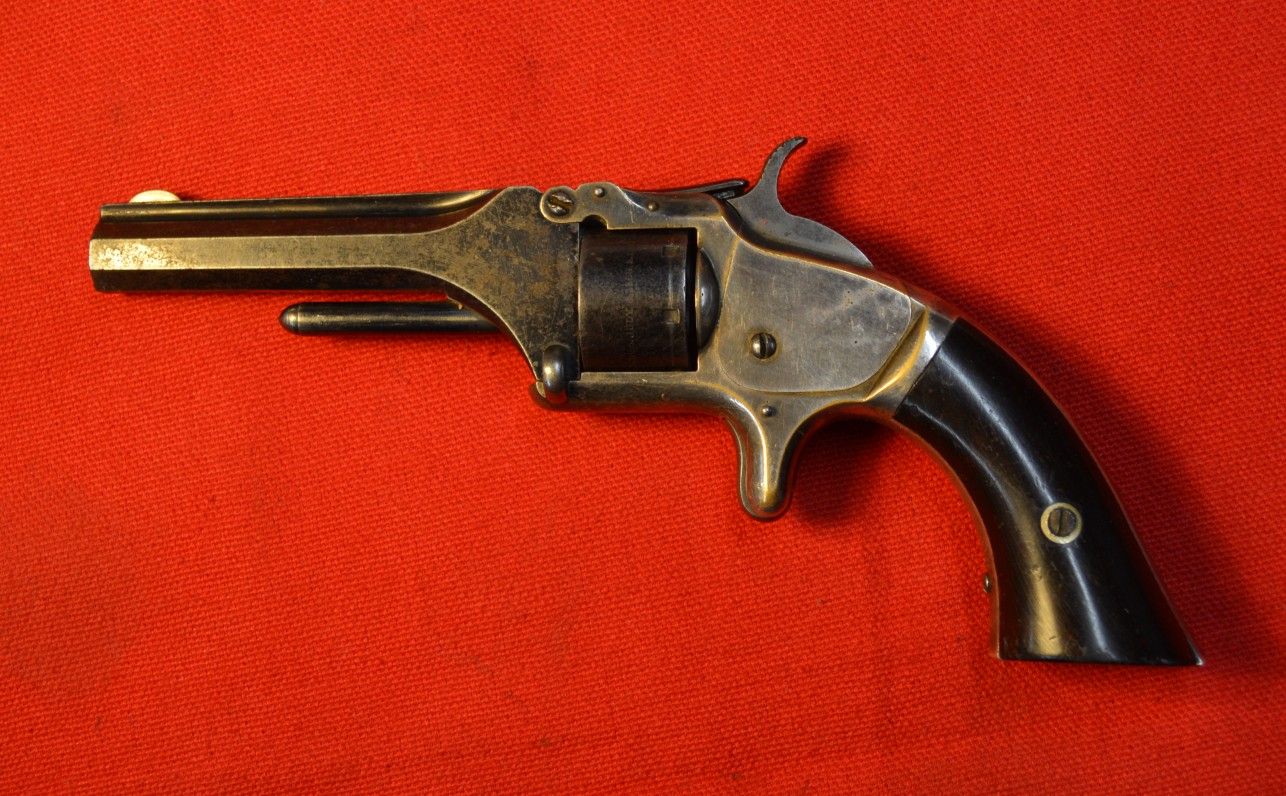 No.1 3rd Issue. Shipped 1870. Identified by the birds head grip and the fluted cylinder. Frame is now iron or steel, I'm not sure which. 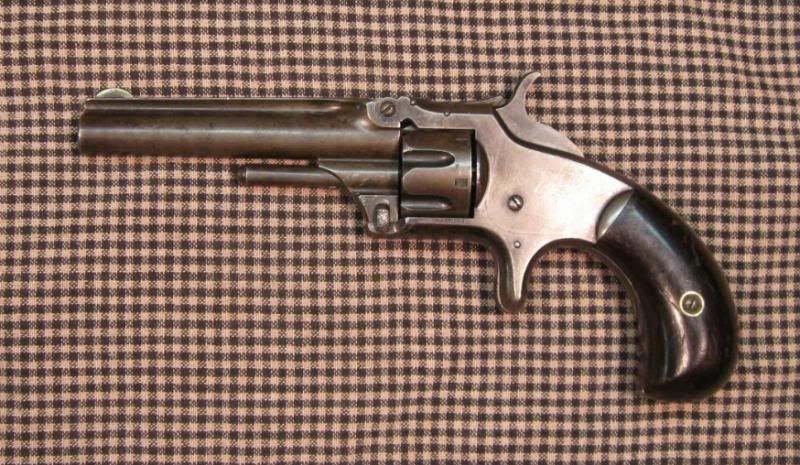 And here is something interesting, a Manhattan Tip Up. Manhattan was a competitor of Smith and Wesson's. I'm not sure exactly when this one was made, I'm going to guess sometime in the 1870s, as the Rollin White patent had expired in 1869. Even so, there are some design differences in this little revolver, probably to get around some other S&W patents. 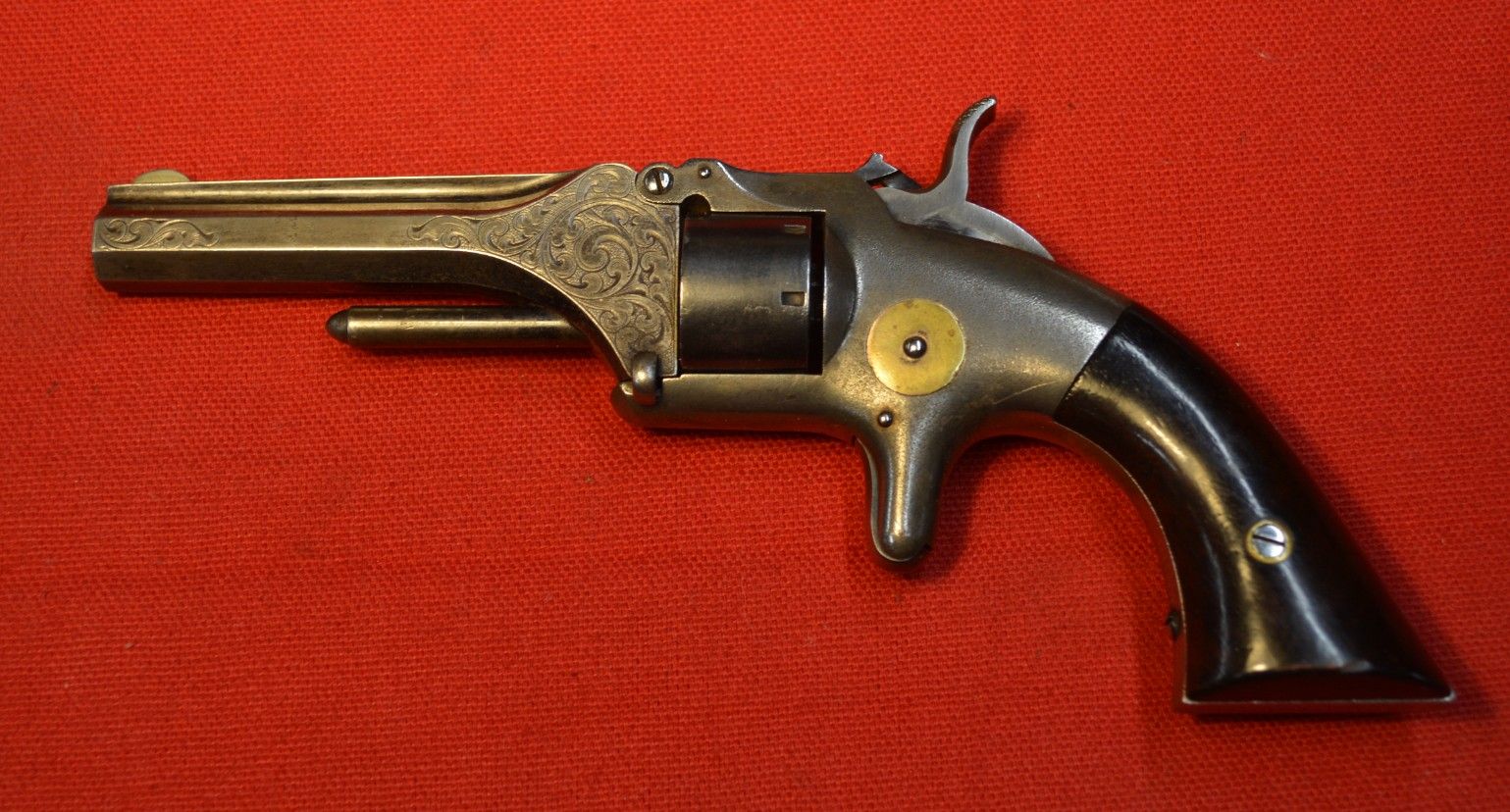 The first thing you have to know about Tip Ups is they were a very weak design. They are called Tip Ups because in order to load them you first pulled up the latch at the bottom of the barrel assembly, then you rotated the barrel up, around the pivot screw in the frame, as opposed to a Top Break where you rotated the barrel down to reload. Then you pulled the cylinder out of the frame. The rod under the barrel was an 'ejector rod', you poked out the empty cartridges from the cylinder using this rod. Then you loaded the cylinder up again, put the cylinder back in place, rotated the barrel back down, and you were ready to go. The Tip Up in this photo is a No. 2 (Old Army) 32 Rimfire which shipped in 1870, with some antique 32 Rimfire ammo. I use this photo as a good illustration of how a Tip Up was loaded,. 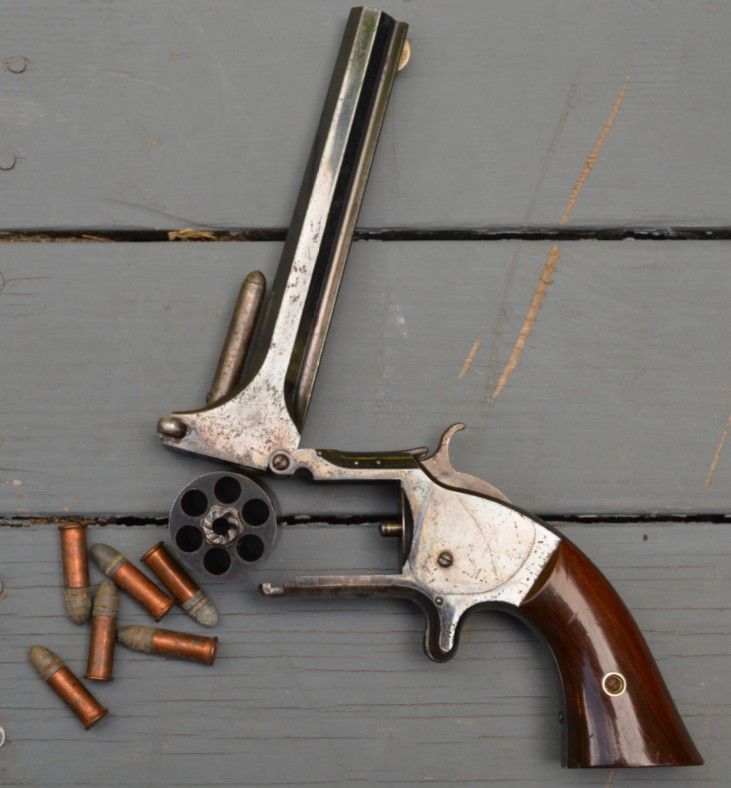 As I said, the Tip Ups were a very weak design. The biggest, most powerful Tip Up S&W produced was that 32 Rimfire No. 2. S&W had a 44 caliber Tip Up under development, and produced a few prototypes, but the model was never offered for sale because S&W determined the Tip Up design was too weak for a 44 caliber cartridge. I cannot post enough photos in one post on this forum to further illustrate the design of the Tip Ups, so I will have to start another post for that. Last edited by Driftwood Johnson; January 18, 2018 at 11:29 AM. |
|
|
|
|
#11 |
|
Senior Member
Join Date: January 3, 2014
Location: Land of the Pilgrims
Posts: 2,033
|
OK, Installment #2.
Here is the lockwork of a No. 1 1/2 Tip Up. Notice the piece mounted above the top strap. That is the bolt. Directly under the bolt is a spring. 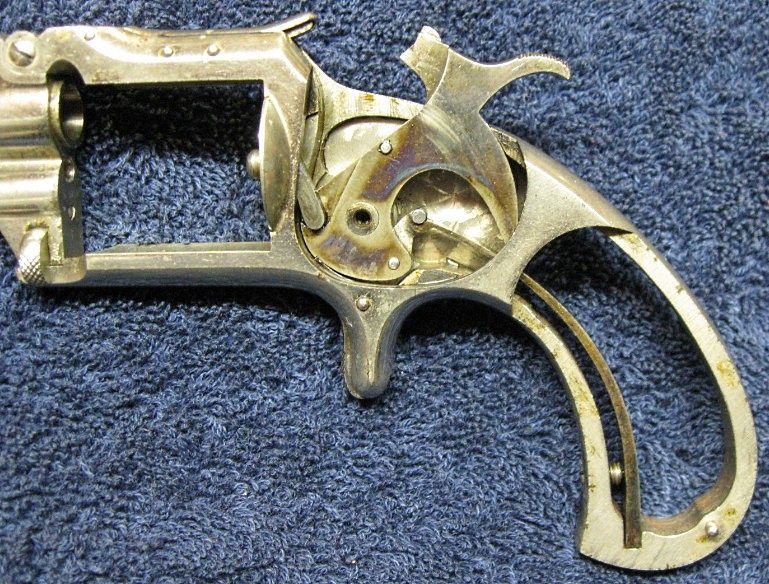 Here is a photo of the hammer and bolt on that No. 2 Old Army. Notice the groove in the bolt, that is the rear sight. More importantly, notice the rounded nub on top of the hammer. 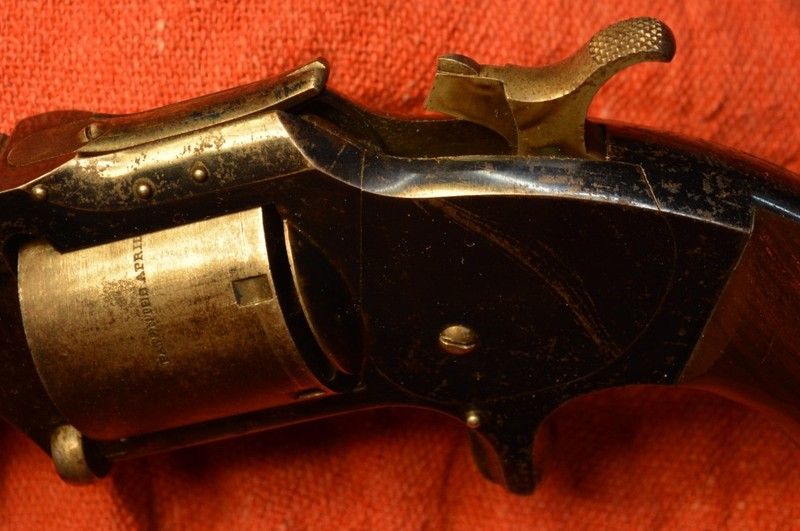 Here is a view of the under side of the bolt. The split piece is the spring. It is actually split almost all the way down its length. Normally the split spring held the bolt down, with the business end of the bolt extending through the top strap and locking the cylinder in battery. When the hammer was cocked, the rounded part of the nub on the hammer levered the bolt up, releasing it from the cylinder and allowing the cylinder to rotate. When the trigger was pulled, as the hammer fell the wedge shaped front of the nub pushed the two sides of the split spring apart. This allowed the hammer to fall, with the spring still holding the bolt down in battery. A very clever and simple system.  There was actually one model Tip Up that had the bolt down under the cylinder, but S&W determined it was too expensive to make it that way, so they reverted to the original system for the rest of the Tip Up production. OK, back to the original question. Would I shoot a Tip Up with modern 22 Shorts? Absolutely not. These little revolvers were designed in the Black Powder era for Shorts loaded with Black Powder. Somewhere I have a reference for how many grains of BP you can fit into a 22 Short, but I can't lay my hands on it right now. Trust me when I say it was a very weak charge. There were many weak features of the Tip Up design. Number one is the pivot screw. Just like a Remington double derringer, the joint would often wear with time and become loose. I have seen plenty of Tip Ups with a loose top joint. Number two is that split spring that operates the bolt. The weak point of this design is the spring would often break at the split, leaving only half the spring in the gun. I have come across a number of Tip Ups that only have a half a spring. Number three is the two early models had brass frames. Not terrifically strong. Prone to stretching. That No. 1 of mine is loose at the latch because the brass has stretched. Modern 22 Shorts? Absolutely not. 22 CB Caps or 22 BB caps? If you can find the original type, that was only powered by a primer, that would probably be OK. But then you would be firing a cartridge that is even weaker than the original Black Powder 22 Shorts, which were pretty weak themselves. What's the point? The CB caps made by CCI today are not primer powered, they have a powder charge in them. I would not use them in one of my Tip Ups. |
|
|
|
|
#12 |
|
Junior member
Join Date: October 20, 2012
Posts: 5,854
|
Uberti should make a repro!
|
|
|
|
|
#13 |
|
Member In Memoriam
Join Date: March 17, 1999
Posts: 24,383
|
FWIW, another maker of "tip up" revolvers that are often taken for S&W's was the Henry Deringer company (Henry himself had passed on), whose revolvers differed from the S&W only in the design of the latch. S&W (or more probably Rollin White) sued and stopped production.
I have been known to have a bit of fun by telling someone that I have a Deringer and then showing them one of those revolvers. Almost inevitably, the response will be that I am badly confused and that the gun is an S&W. Nope. http://www.gunsinternational.com/gun...n_id=100942733 Jim |
|
|
|
|
#14 | |
|
Junior member
Join Date: October 20, 2012
Posts: 5,854
|
Quote:

|
|
|
|
|
|
#15 |
|
Member In Memoriam
Join Date: March 17, 1999
Posts: 24,383
|
The little sliding button below the cylinder is the release for the latch. Otherwise, the Deringer is exactly the same as the S&W.
Jim |
|
|
|
|
#16 |
|
Senior Member
Join Date: January 3, 2014
Location: Land of the Pilgrims
Posts: 2,033
|
Howdy Again
Thanks for pointing out that Deringer Tip Up. I was not aware of them, always learn something new. However I must disagree with you that the only difference between it and the S&W Tip Ups was the latch. Looking at the photos of the example you posted, it appears to me the Deringer Tip Up had the bolt on the bottom of the frame, not so different than most modern revolvers. As I said earlier, the S&W Tip Ups had the bolt on the top of the frame. Almost all of them. At the top of this photo is a S&W Model #1 1/2 New Model and at the bottom is a #1 1/2 Old Model. Notice the bolt protruding back out of the top strap on the New Model. Notice one does not see that on the Old Model. 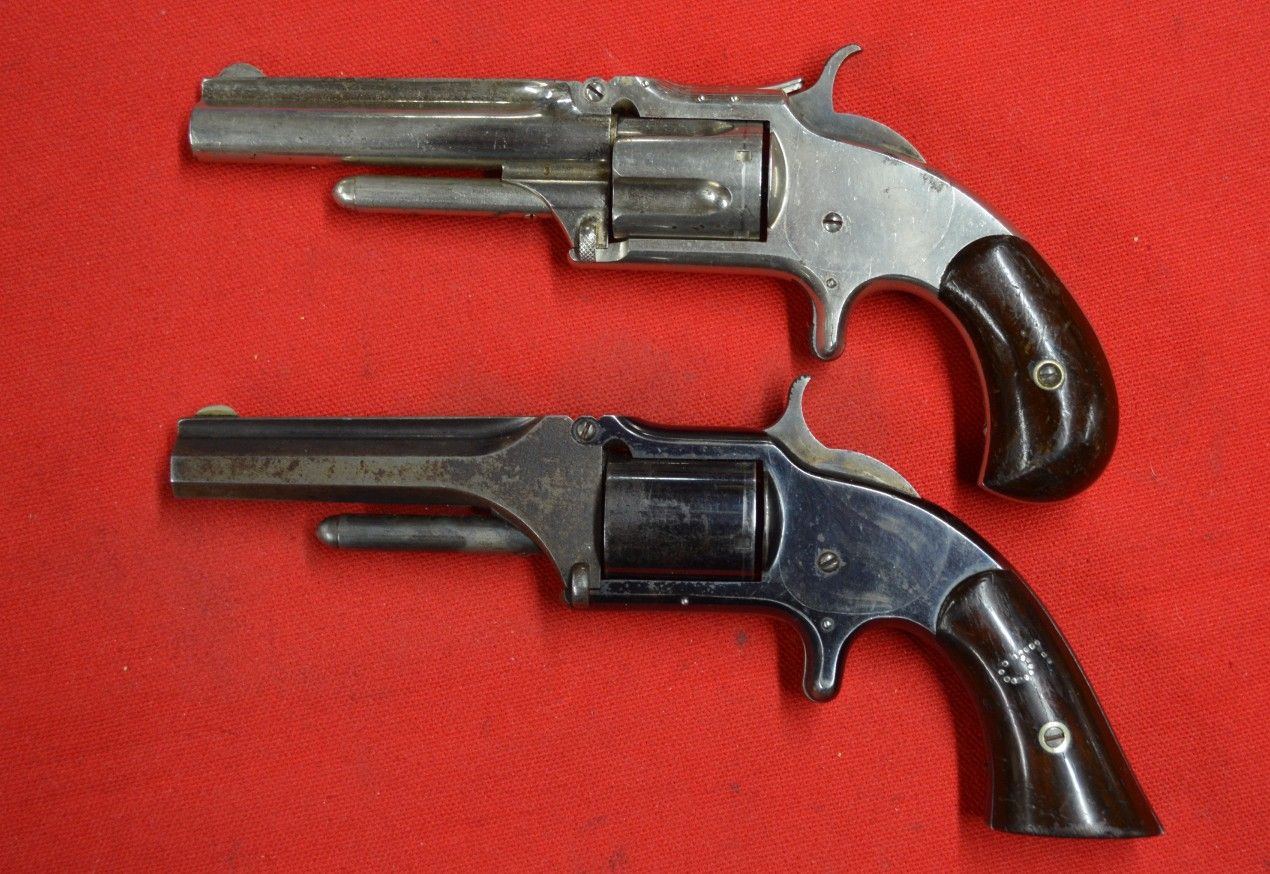 The # 1 1/2 Old Model was the only Tip Up S&W made with the bolt under the cylinder. In this photo we see how smooth the top strap is. 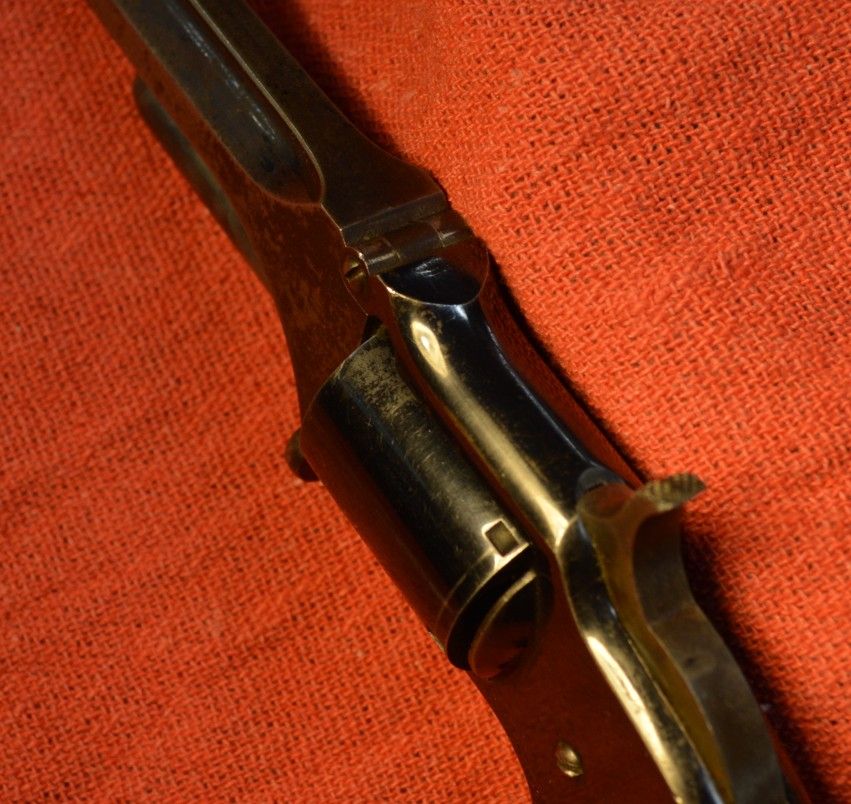 In this photo we see the bolt popping up out of the frame where it was positioned under the frame. This appears to me to be the situation with the Deringer Tip Up. 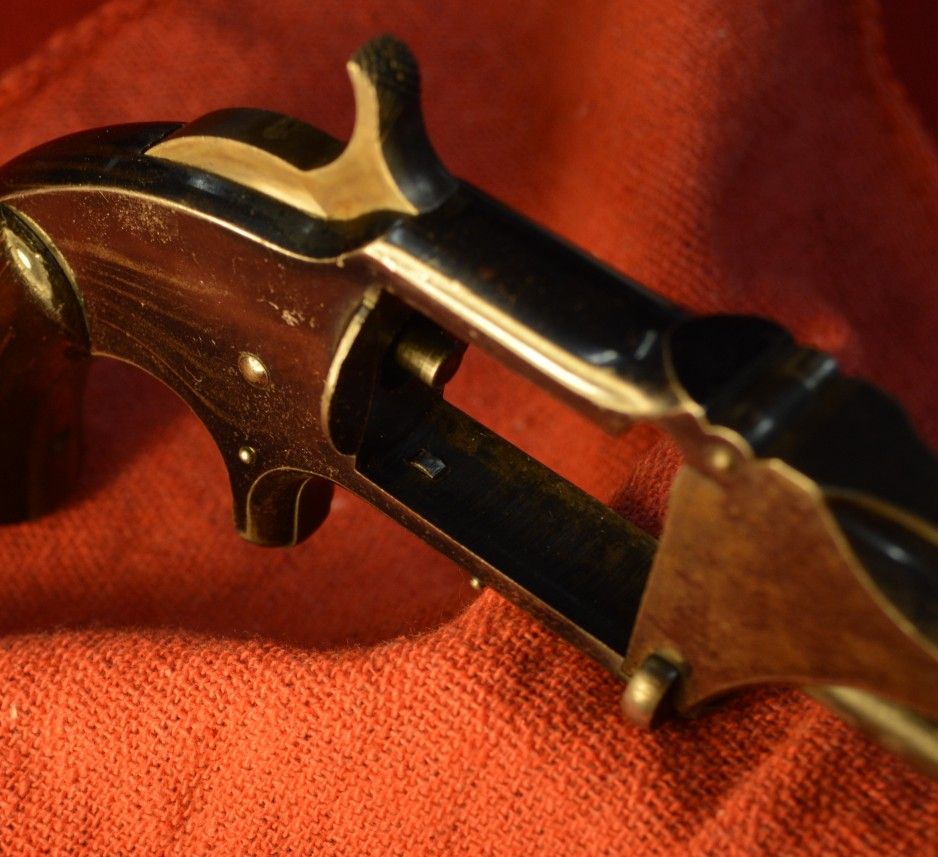 However the S&W # 1 1/2 New Model had the typical S&W Tip Up construction with the bolt on the top strap. 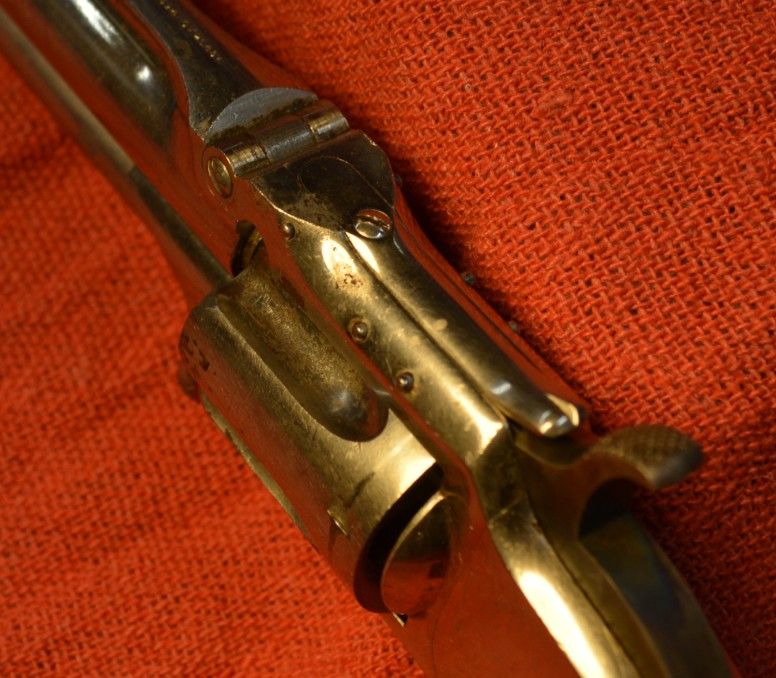 Here is the way the bolt protruded through the top strap of the #1 1/2 New Model. The hammer nose is protruding through the recoil shield, and the bolt is protruding down through the top strap. 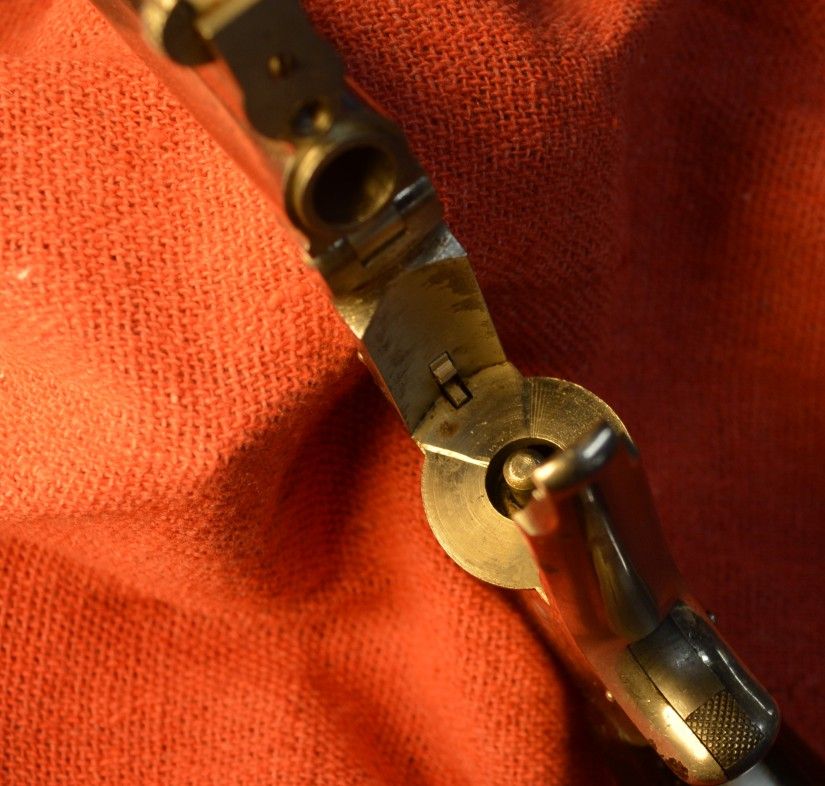 All of the S&W Tip Ups, with the exception of the #1 1/2 Old Model had the bolt mounted on the top strap. You need to know a little bit of history about the S&W Tip Ups, which is another interesting story. First came the tiny 22 caliber #1 Tip Ups. But S&W realized pretty soon that a little revolver firing a 22 Short was not going to be a very good man stopper. So in 1861 they introduced a bigger model. This one was a six shot 32 caliber revolver. Since it was bigger than the #1, they called it the #2. That was the Old Army model that was popular during the Civil War. The #2 was not a big pistol compared to modern revolvers, but it was a lot bigger than the #1 and the standard barrels were either 5" or 6". Not too difficult to conceal, but they were usually carried in a belt holster. At the end of the Civil War, many municipalities were passing laws against open carry, so S&W decided to introduce a 'mid size' model. This one was 32 caliber, but it was only 5 shots. Since it was halfway in between the #1 and the #2 in size, Smith did the most logical thing they could and called this frame size the Model 1 1/2. Anyway, I asked Roy Jinks not too long ago why the # 1 1/2 Old Model had the bolt on the bottom. He told me that when the #1 1/2 was designed, S&W already knew a bolt under the cylinder was a better design. But it turned out it was more expensive to make them this way, so when the # 1 1/2 New Model came out, they reverted to the less expensive construction with the bolt on the top. |
|
|
|
|
#17 |
|
Senior Member
Join Date: January 3, 2014
Location: Land of the Pilgrims
Posts: 2,033
|
Two more photos, then I'll shut up.
This photo is a comparison of the three sizes of Smith and Wesson Tip Ups, and a modern K frame Smith. Top to bottom, a Model 17, Model #2, Model # 1 1/2, Model #1. 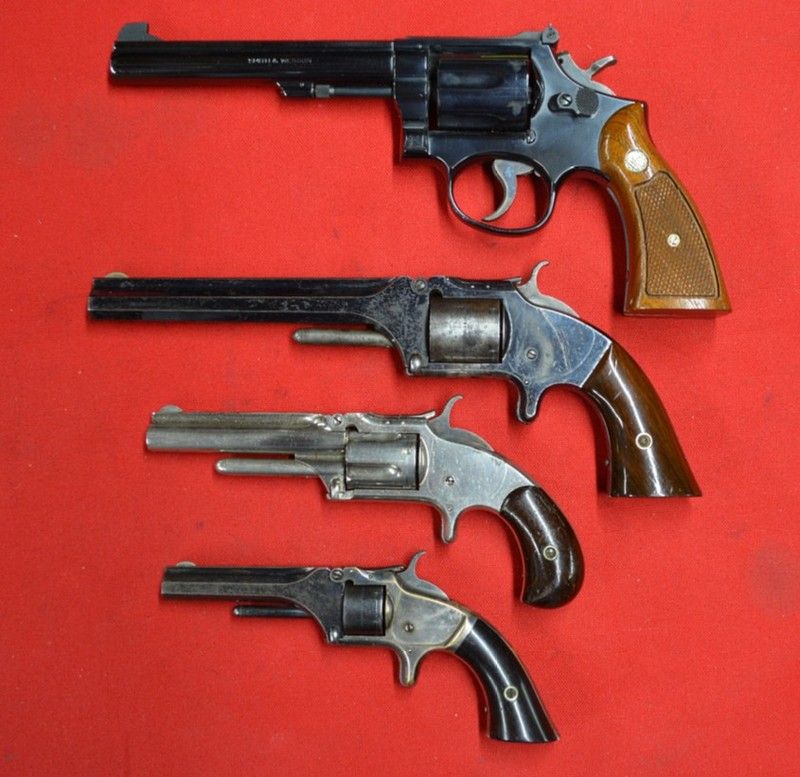 This photo shows the same Tip Ups with a #3 size Russian Model. 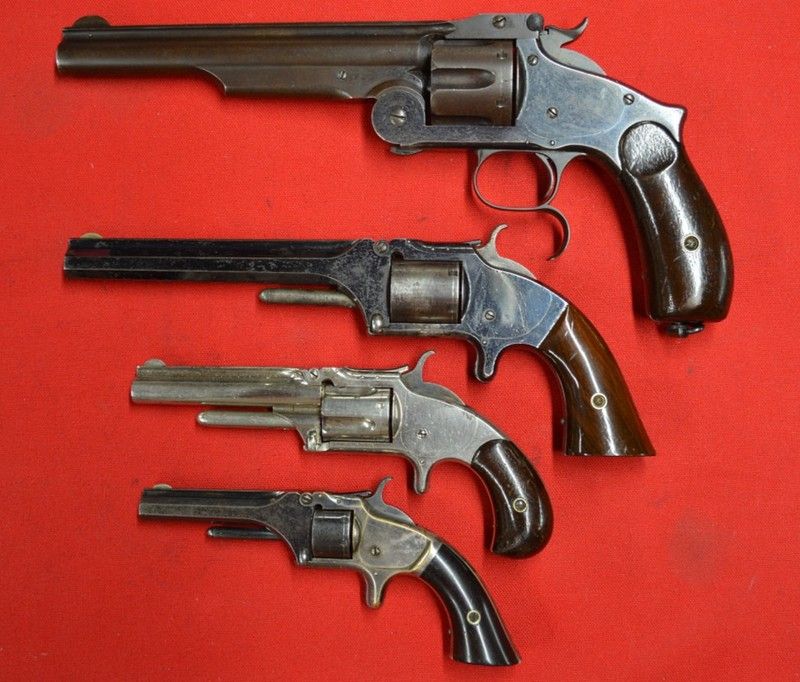
|
|
|
|
|
#18 |
|
Member In Memoriam
Join Date: March 17, 1999
Posts: 24,383
|
Hi, Driftwood,
You are right, the cylinder stop is in the bottom of the frame, actually a better system than the S&W. My goof. Jim |
|
|
 |
|
|